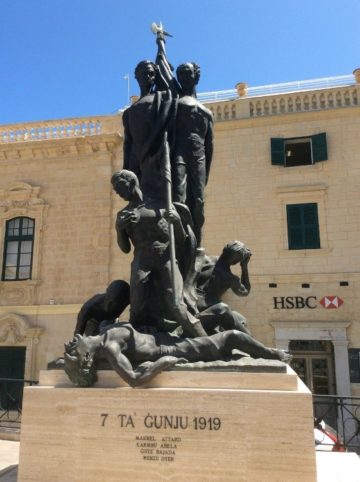Sette Giugno
Did you know that Malta celebrates another public holiday on Friday the 7th of June? For many AM language students, this means a long weekend full of exciting adventures and new possibilities. Given the time of year, we imagine you will probably enjoy one of the many lovely beaches on the island. For the Maltese, however, the 7th of June, also known as the Sette Giugno, marks a very important day in the island’s history. On this day in 1919, four Maltese people were killed and hundreds of others injured during a national protest against the British government. In this post, we’ll be taking a look at the historical background of this public holiday, the events that unfolded on the 7th of June 1919, as well as things you might want to do on this day.
Sette Giugno History
The First World War left the European economy in a bad state. The disruption of agriculture and industry all across the continent led to food shortages, which in turn also meant a dramatic increase in the price of food. Most people couldn’t keep up with the cost of living, and the situation was not any different in Malta.
By the time the First World War came to an end in 1918, Malta had already been under British Colonial rule for over 100 years (since 1813). The situation in Europe also affected the Maltese Islands, and due to heavy restrictions on imports, the British were not able to provide an adequate supply of food to the Maltese people. Additionally, despite various wage increases, many Maltese could not afford to buy food, especially bread, which was, and still, is considered to be a staple source of food in the Maltese diet.
Another factor that contributed to the riots of the 7th of June of 1919 was the political situation that the Maltese National Assembly faced. Following the First World War, the Maltese were fighting for a constitution that would grant them political representation. The Versaille Peace Conference had awarded the island the right for independence from the British, but the British did not want to allow this.
As a result, on the 7th of June, thousands of Maltese marched into Valletta to protest against British rule, demanding a representative government for the Maltese, and also cheaper prices for bread. On this day, during clashes with British troops, four Maltese people were killed and hundreds of others injured.
Sette Giugno Monument
You can visit the Sette Giugno monument outside the Grand Master’s Palace, in St. George’s square in Valletta. It was designed by Anton Agius, one of Malta’s most famous artists and sculptors of the 20th century. The monument shows two Maltese people proudly holding the Maltese flag, surrounded by four victims who represent not only those who died, but the hundreds of others who were injured.










